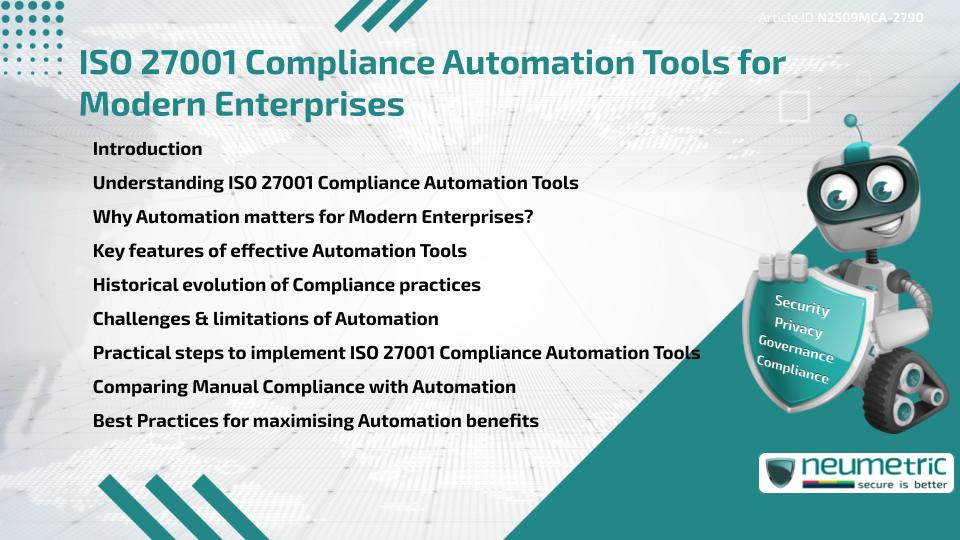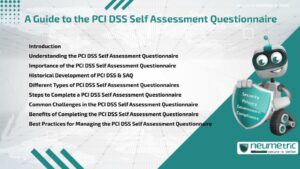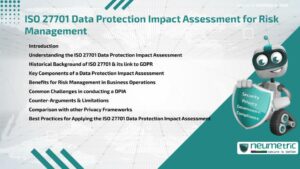Table of Contents
ToggleIntroduction
Managing ISO 27001 Compliance is often complex & time-consuming, requiring Enterprises to track Documents, Controls & Audits across multiple Systems. ISO 27001 Compliance Automation Tools simplify this process by reducing manual effort, minimising errors & ensuring continuous alignment with the standard. For Modern Enterprises, these Tools provide efficiency, scalability & confidence in passing Certification Audits. This article explores what ISO 27001 Compliance Automation Tools are, why they matter, their features, challenges & best practices for implementation.
Understanding ISO 27001 Compliance Automation Tools
ISO 27001 Compliance Automation Tools are Software Solutions designed to help Organisations manage their Information Security Management System [ISMS] efficiently. They automate tasks such as Policy Management, Control Monitoring, Audit Preparation & Risk Assessment.
Instead of relying on Spreadsheets & scattered Documents, Enterprises can centralise all Compliance activities into a single platform. This reduces duplication & ensures that Auditors have quick access to accurate, up-to-date Evidence.
Why Automation matters for Modern Enterprises?
Modern Enterprises operate in fast-paced environments where manual Compliance efforts can no longer keep up. Automation Tools offer several advantages:
- Time savings: Repetitive tasks such as Control monitoring are handled automatically.
- Error reduction: Automated Systems minimise Human mistakes.
- Scalability: Enterprises with multiple Sites or Business units can manage Compliance consistently.
- Real-time visibility: Dashboards provide instant Insights into Compliance status.
For Enterprises under constant pressure from evolving Threats & Regulations, Automation ensures that Compliance remains efficient & reliable.
Key features of effective Automation Tools
The most useful ISO 27001 Compliance Automation Tools typically include:
- Policy Management: Templates & Workflows for creating & updating Policies.
- Control Tracking: Automated mapping of Controls to ISO 27001 requirements.
- Audit Readiness: Centralised Evidence collection for easier Audits.
- Risk Assessment: Tools for identifying & prioritising Risks.
- Incident Tracking: Integration with Security Systems for real-time reporting.
- Alerts & Reminders: Notifications for upcoming reviews or overdue tasks.
These features transform Compliance from a static, reactive exercise into a proactive, ongoing process.
Historical evolution of Compliance practices
In the past, Compliance was largely manual. Organisations relied on Paper Files & basic Spreadsheets to manage their ISMS. This approach was prone to error, time-intensive & difficult to scale.
The introduction of specialised Compliance Software marked a turning point, enabling Enterprises to automate repetitive tasks. Today, Modern Tools leverage Cloud Platforms, Integrations & Dashboards to provide Enterprises with continuous Compliance Management.
Challenges & limitations of Automation
Despite the advantages, Enterprises may face some challenges:
- Cost: Licensing fees can be high, especially for Small Enterprises.
- Complexity: Configuring Tools to match unique processes may require Expertise.
- Overreliance: Automation should not replace Human judgment or Oversight.
- Change resistance: Employees may resist moving away from familiar Manual Systems.
Recognising these limitations ensures Organisations adopt Tools realistically & effectively.
Practical steps to implement ISO 27001 Compliance Automation Tools
Enterprises looking to adopt Automation should:
- Assess current Compliance Processes to identify gaps & inefficiencies.
- Select Tools that integrate with existing systems such as HR or Security Platforms.
- Train Staff on both Technical & Procedural aspects of the tool.
- Start with critical Compliance Tasks before scaling to broader functions.
- Continuously monitor & refine tool usage to match evolving needs.
This structured approach ensures a smooth transition from Manual Processes to Automated Compliance.
Comparing Manual Compliance with Automation
Manual Compliance often relies on scattered Spreadsheets & repetitive reviews, while Automation centralises tasks into streamlined Workflows.
An analogy can be drawn with navigation: manual Compliance is like using a Paper map, while Automation is like using a GPS-it provides real-time updates, reduces errors & helps you reach your destination more efficiently.
Best Practices for maximising Automation benefits
To fully benefit from ISO 27001 Compliance Automation Tools, Enterprises should:
- Choose scalable solutions that can grow with the Business.
- Integrate Tools with broader Security & Governance Systems.
- Involve multiple Departments in tool adoption to increase Engagement.
- Regularly review Automated Outputs to maintain Accuracy.
- Treat Automation as a complement to Human Oversight, not a replacement.
These practices ensure that Automation strengthens Compliance without undermining Accountability.
Takeaways
- ISO 27001 Compliance Automation Tools streamline Compliance by centralising & automating tasks.
- Benefits include time savings, reduced errors, scalability & real-time visibility.
- Effective Tools feature Policy Management, Risk Assessment & Audit Readiness.
- Compliance practices evolved from Manual records to integrated, Cloud-based Tools.
- Challenges include cost, complexity & overreliance on Automation.
- Implementation requires careful Assessment, Training & Phased adoption.
- Automation should be complemented by Human Oversight for best results.
FAQ
What are ISO 27001 Compliance Automation Tools?
They are Software Solutions that Automate Compliance Tasks such as Policy Management, Control Tracking & Audit Preparation.
Why do Enterprises need Automation for ISO 27001?
Because Manual processes are slow, error-prone & difficult to scale across complex Organisations.
What features should Compliance Automation Tools include?
Key features include Policy Management, Control Tracking, Audit Readiness, Risk Assessment & Incident Tracking.
What challenges come with using Automation Tools?
Challenges include high Costs, Configuration complexity, Staff resistance & overreliance on Technology.
How do Automation Tools compare with manual Compliance?
Manual Compliance relies on repetitive Tasks & scattered Records, while Automation centralises Workflows & provides real-time Insights.
Can Small Enterprises benefit from Compliance Automation?
Yes, even Small Enterprises can benefit from reduced errors & efficiency, though cost may be a limiting factor.
What is the role of Human Oversight in Compliance Automation?
Human Oversight ensures that Automation outputs are accurate, relevant & aligned with Organisational goals.
Need help for Security, Privacy, Governance & VAPT?
Neumetric provides organisations the necessary help to achieve their Cybersecurity, Compliance, Governance, Privacy, Certifications & Pentesting needs.
Organisations & Businesses, specifically those which provide SaaS & AI Solutions in the Fintech, BFSI & other regulated sectors, usually need a Cybersecurity Partner for meeting & maintaining the ongoing Security & Privacy needs & requirements of their Enterprise Clients & Privacy conscious Customers.
SOC 2, ISO 27001, ISO 42001, NIST, HIPAA, HECVAT, EU GDPR are some of the Frameworks that are served by Fusion – a SaaS, multimodular, multitenant, centralised, automated, Cybersecurity & Compliance Management system.
Neumetric also provides Expert Services for technical security which covers VAPT for Web Applications, APIs, iOS & Android Mobile Apps, Security Testing for AWS & other Cloud Environments & Cloud Infrastructure & other similar scopes.
Reach out to us by Email or filling out the Contact Form…





